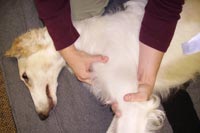print
Manual TherapyManual therapy encompasses any form of therapy that can be applied by the use of the therapist’s hands. Manual therapy can incorporate joint mobilization, manipulation, traction, soft tissue massage, myofascial release, and stretching. When treating any joint dysfunction, the therapist should use an integrated approach which targets not only the restoration of joint position, but also the restoration of proper muscle tone, muscular stabilization, and retraining of motor control and timing (coordination and appropriate timing of muscle contractions during motion) of all the contractile structures within the anatomical area being treated. Mobilization has been described as a gentle coaxing of movement by passive rhythmical oscillations. These movements can be performed within different ranges of the joint and with varying intensities in order to accomplish one of two goals: 1) The treatment of stiffness; 2) The treatment of pain. (i.e. to gain movement in a stiff joint, a vigorous mobilization is applied near the limit of the joint’s movement, whereas to reduce pain, a gentle mobilization is performed in a position of comfort for the joint.) Traction in animals is done solely by manual techniques. It is know from human studies that gentle traction is very beneficial in cases of nerve root compression along the spine. Traction acts by increasing circulation at the target level in the spinal level which aids in the resorption of extruded disc material and in resolving inflammation around nerve roots. Soft Tissue Techniques may include massage, myofascial release or stretching. These techniques can be utilized to normalize muscle tone, reduce muscular trigger points, promote blood flow to tight/restricted areas, and elongate shortened muscle structures. The combination of mobilizations and soft tissue techniques is imperative to full restoration of any joint or spinal dysfunction. Examples of Indications for Manual Therapy:
|

|
